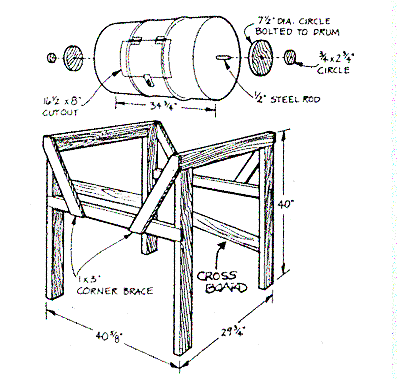 3R's in the Home
3R's in the Home
ROTATING BARREL COMPOSTER
- If your composting operation is small and you neither relish nor have the
time for turning garbage, then you'll find this composter suited to your
needs. The barrel is rotated several times whenever new materials are added.
It is constructed with a minimum of hand-powered tools, and is not difficult
or time-consuming to build. It will cost about $60 to build providing you use
second-hand materials.
-

- MATERIALS
1 - 45-gallon drum, use 'food grade' drum only (composter)
4 - 40 x 2 x 4" (frame uprights)
2 - 29 3/4 x 2 x 4" (frame
horizontals)
2 - 40 5/8 x 1 x 3" (cross braces) white pine
4 - 23 3/4
x 1 x 3" (corner braces) white pine
2 - 27 x 2 x 4" (cross boards) white
pine
2 - 7 1/2" dia. x 3/4" (bearings) white pine or plywood
2 - 2
3/4" dia. x 3/4" (bearings) white pine or plywood
2 - 1 1/2 x 2" hinges
1 - small hasp
1 - 1/2 x 40 1/2" steel rod
8 - 1/4 x 1 1/4" stove
bolts
12 - 1/4 x 1" stove bolts
28 - 1 1/2" #10 wood screws
wood
glue
approximately 1 pint of flat black paint
-
- CONSTRUCTION
- Obtain a good 45-gallon drum that has not had any toxic chemicals in it.
Ask for a 'food grade' barrel. It must be unpainted on the inside and
de-rusted. Add a protective coating inside. A plastic drum can also be used.
- Drill a 1/2" hole in the exact centre of both ends of the barrel to
accommodate the 1/2" steel rod. (See illustration for how to make a simple
tool to locate centres.) Hold the rounded end of the gauge anywhere along the
circumference and scribe a line on the approximate centre. Move the gauge 90
degrees and scribe another line. The intersection of these lines will be the
exact centre.
- Next scribe the lines for the opening in the barrel making sure to round
the corners slightly. Drill a 1/4" hole somewhere along one of the lines to
start the saber saw. If your barrel has ribs, as most do, you will have to cut
a 1" vee notch on each rib to facilitate opening the door. Attach the hinges
and the hasp to the barrel and lid using 1 x 1/4" stove bolts.
- From 3/4" white pine, cut two circles 7 1/2" in diameter and two circles 2
3/4" in diameter. Drill a 1/2" hole in the centre of each and apply glue to
the 2 3/4" circles. Glue the 2 3/4" circles to the 7 1/2" circles. This can be
done easily if the circles are temporarily slipped over the 1/2" steel rod and
clamped. After the glue has dried, remove the disks, insert the rod through
the barrel and assemble as shown in the illustration, using four 1 1/4 x 1/4"
stove bolts in each.
- To build the support frame, cut the 2-by-4's to length and, using a corner
lap joint, assemble with two 1 1/2" #10 wood screws in each joint. The
uprights will also have to be dadoed 23 inches from the bottom to accept a 1 x
3" board. To make a corner lap joint, simply remove one-half the thickness of
the stock to a length comparable to the width of the stock, on both ends of
all pieces.
- Half-inch holes to accommodate the rod will have to be drilled in the
exact centre of the top horizontal pieces before assembling the top portion of
the support frame. Slip the 1/2" steel rod with barrel attached, through these
holes and insert the cross members into the dadoed uprights. Fasten with 1
1/2" #10 wood screws. Next cut the 1 x 3 x 23 1/4" piece at 45-degree angles
at both ends, and attach with 1 1/2" #10 wood screws across corners as shown
in the illustration.
- For extra support, use 2 x 4 x 27" cross boards on each side. Cut them to
an angle as the upper end is at 14 1/2" and lower end at 29" from the top of
the 2 x 4 frame horizontals.
- Drill several rows of 1/4" holes along the bottom of the barrel exactly
underneath the door opening to eliminate excess moisture. Paint the outside of
the unit a flat black colour.
- (This design information was taken from the book The Rodale Guide to
Composting, by Jerry Minnich, Marjorie Hunt, and the Editors of Organic
Gardening Magazine, Rodale Press, Emmaus, PA)
Update June 1998.
The Recycling Council of Ontario's e-mail address is: rco@rco.on.ca.
 Back to RCO Factsheets page.
Back to RCO Factsheets page.
 3R's in the Home
3R's in the Home
 3R's in the Home
3R's in the Home
